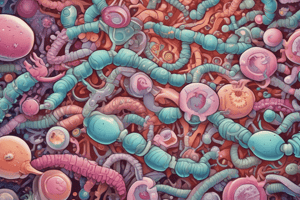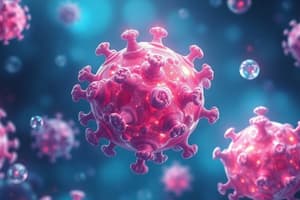Podcast
Questions and Answers
Which type of streptococci is known as S.pyogenes?
Which type of streptococci is known as S.pyogenes?
- Group C
- Group D
- Group A (correct)
- Group B
What distinguishes the M protein from the T protein in S.pyogenes?
What distinguishes the M protein from the T protein in S.pyogenes?
- Heat resistance
- Trypsin resistance (correct)
- Acid resistance
- Agglutination
How are Lancefield groups further subdivided in S.pyogenes typing?
How are Lancefield groups further subdivided in S.pyogenes typing?
- By cellular morphology
- By DNA sequences
- By protein antigens (correct)
- By lipopolysaccharides
At what temperature does S.pyogenes grow best?
At what temperature does S.pyogenes grow best?
What kind of colonies are produced by S.pyogenes on blood agar after 24 hours of incubation?
What kind of colonies are produced by S.pyogenes on blood agar after 24 hours of incubation?
In what kind of media does S.pyogenes grow best?
In what kind of media does S.pyogenes grow best?
What is the main reason for chain formation in streptococci?
What is the main reason for chain formation in streptococci?
Which of the following is NOT a characteristic of streptococci morphology?
Which of the following is NOT a characteristic of streptococci morphology?
In what year did Rebecca Lancefield report a serological method of grouping streptococci?
In what year did Rebecca Lancefield report a serological method of grouping streptococci?
What type of acid are the capsules composed of in some strains of S.pyogenes and group C streptococci?
What type of acid are the capsules composed of in some strains of S.pyogenes and group C streptococci?
Which order do streptococci belong to?
Which order do streptococci belong to?
What is the main habitat where streptococci of veterinary interest live as commensals?
What is the main habitat where streptococci of veterinary interest live as commensals?
Which Streptococcal toxin is responsible for the beta hemolysis seen around streptococcal colonies on blood agar plates?
Which Streptococcal toxin is responsible for the beta hemolysis seen around streptococcal colonies on blood agar plates?
Which Streptococcal toxin promotes the lysis of fibrin clots by activating plasminogen?
Which Streptococcal toxin promotes the lysis of fibrin clots by activating plasminogen?
Which Streptococcal toxin is antigenic and elicits an anti-streptolysin response in sera following Streptococcal infection?
Which Streptococcal toxin is antigenic and elicits an anti-streptolysin response in sera following Streptococcal infection?
Which Streptococcal toxin enhances susceptibility to lethal shock by endotoxin?
Which Streptococcal toxin enhances susceptibility to lethal shock by endotoxin?
What is the specific cardiotoxic activity of a Streptococcal toxin?
What is the specific cardiotoxic activity of a Streptococcal toxin?
Which Streptococcal toxin has been experimentally shown to be nephrotoxic?
Which Streptococcal toxin has been experimentally shown to be nephrotoxic?
What is a common complication of the infection described in the text?
What is a common complication of the infection described in the text?
Which animal infection can lead to abscesses developing in various organs as a very serious complication?
Which animal infection can lead to abscesses developing in various organs as a very serious complication?
What is a common symptom in chickens infected by the pathogen described in the text?
What is a common symptom in chickens infected by the pathogen described in the text?
Which infection is associated with causing acid milk in puppies and canine tonsillitis?
Which infection is associated with causing acid milk in puppies and canine tonsillitis?
What type of examination is involved in the diagnosis of the infection described in the text?
What type of examination is involved in the diagnosis of the infection described in the text?
Which animal infection can lead to porcine cervical lymphadenitis and erosive arthritis in young pigs?
Which animal infection can lead to porcine cervical lymphadenitis and erosive arthritis in young pigs?
What causes sudden onset of acute inflammation of one quarter only, followed by joint infections and lameness?
What causes sudden onset of acute inflammation of one quarter only, followed by joint infections and lameness?
Which bacterium produces bluish-grey colonies on Edward's medium?
Which bacterium produces bluish-grey colonies on Edward's medium?
Which test is used for differentiating between pneumococcus and S.viridans organisms?
Which test is used for differentiating between pneumococcus and S.viridans organisms?
Which bacterium is completely lysed in the CAMP test?
Which bacterium is completely lysed in the CAMP test?
Which bacterium shows autolysis within 15 minutes in the bile solubility test?
Which bacterium shows autolysis within 15 minutes in the bile solubility test?
Which organism is sensitive to optochin in the optochin test?
Which organism is sensitive to optochin in the optochin test?
Flashcards are hidden until you start studying
Study Notes
Streptococci Systematics
- Domain: Bacteria
- Phylum: Firmicutes
- Class: Bacilli
- Order: Lactobacillales
- Family: Streptococcaceae
- Genus: Streptococcus
- Species: S. agalactiae, S. dysgalactiae, S. equi subsp. zooepidemicus, S. uberis, S. equi subsp. equi, S. canis, S. suis, S. pyogenes (human)
History
- Rivolta (1873): described chain-forming organisms in pus from a case of strangles in horses
- Pasteur (1878-79): recognized streptococci as a pus-forming agent
- Hugo Schottmuller (1903): introduced blood to differentiate various types of hemolysis
- Rebecca Lancefield (1928): reported a serological method of grouping streptococci
Habitat
- Worldwide distribution
- Most streptococci live as commensals in the mucosa of the upper respiratory and lower urogenital tracts
- Do not survive for long away from animal hosts
Morphology
- Gram-positive, spherical or ovoid cells, arranged in chains or pairs
- Chain formation: cocci dividing in one plane only, with daughter cells failing to separate completely
- Each coccus: about 1 mm in diameter
- Facultative anaerobes, catalase-negative, oxidase-negative, non-spore-forming, and non-motile (except some enterococci)
Cultural Characteristics
- Aerobes and facultative anaerobes, growing best at 37°C
- Grow best in media enriched with blood, serum, and fermentable carbohydrates
- Produce small, circular, semitransparent colonies with an area of clear hemolysis on blood agar
Virulence Factors
- Streptolysin O: antigenic, general cytotoxin, responsible for beta-hemolysis
- Streptolysin S: oxygen-stable hemolysin, responsible for beta-hemolysis, nephrotoxic
- Erythrogenic toxin (Streptococcal pyogenic exotoxins/Dick toxin): four types, pyogenic, enhance susceptibility to lethal shock by endotoxin
- Streptokinase (Fibrinolysin): produces fibrinolysin, activates plasminogen, lyses fibrin clots
Studying That Suits You
Use AI to generate personalized quizzes and flashcards to suit your learning preferences.




